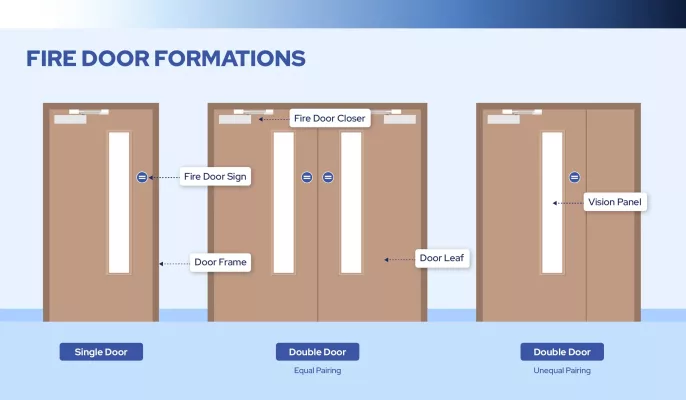Abstract-Implementation of Steel Fireproof Door This paper outlines the technical process for the installation of steel fireproof doors, emphasizing the expertise of the China fire door factory, Henan Yuankai Door Industry Co., Ltd. It delves into the preparation, tools required, and detailed steps for the successful installation of multi-door access systems for steel fireproof doors. […]
Tag Archives: Steel fireproof door
Steel Fireproof Door: Comprehensive Technical Guide
1. Definition & Purpose
A steel fireproof door is a passive fire protection system designed to:
Compartmentalize fires (prevent spread)
Maintain structural integrity during fire exposure
Provide safe egress routes
Block smoke/toxic gases
2. Key Performance Metrics
| Parameter | Standard | Requirement |
|---|---|---|
| Fire Resistance | UL10C/EN1634 | 30-240 minutes |
| Smoke Control | EN1634-3 | ≤25m³/h·m² leakage |
| Thermal Insulation | EN13501-2 | ΔT<140°C (unexposed side) |
| Structural Stability | BS476-22 | No collapse during test |
3. Material Composition
A. Core Structure
Base Layer: 1.2mm galvanized steel sheet (DX51D+Z)
Insulation:
Mineral wool (density: 110-150kg/m³)
Vermiculite boards (for high-temp stability)
Ceramic fiber (industrial applications)
Expansion Layer: Intumescent graphite strips (activate at 180-300°C)
B. Critical Components
Frame: 2mm thick steel with thermal break
Seals: Triple-layer system:
Cold smoke seal (EPDM)
Intumescent seal (sodium silicate-based)
Thermal barrier (ceramic fiber tape)
Hardware:
304 stainless steel hinges (3-4 per door)
Fusible-link automatic closers
Fire-rated mortise locks (EN12209)
4. Manufacturing Process Flow
Phase 1: Metal Fabrication
Laser Cutting:
Tolerance: ±0.5mm
Nesting efficiency: ≥85%
Press Brake Forming:
200-ton hydraulic press
Angle tolerance: ±0.5°
Welding:
Robotic MIG welding
Seam length: Continuous perimeter
Phase 2: Core Assembly
Adhesive Application:
High-temp epoxy (300°C rating)
Coverage: 95% surface area
Layering Sequence:
Steel outer skin
Ceramic fiber mat (2mm)
Mineral wool core
Intumescent interlayer
Hot Pressing:
Temperature: 160°C
Pressure: 15kg/cm²
Duration: 45 minutes
Phase 3: Finishing
Surface Treatment:
Zinc phosphating (15μm)
Electrophoretic primer (20μm)
Powder coating (60-80μm)
Curing:
IR oven: 200°C × 20min
Phase 4: Quality Verification
Non-Destructive Testing:
Ultrasonic thickness measurement
X-ray weld inspection
Performance Testing:
Furnace test (ISO834 curve)
Hose stream test (ASTM E119)
Cyclic durability (100,000 cycles)
5. Technical Specifications Table
| Feature | Standard Door | High-Performance Variant |
|---|---|---|
| Thickness | 45mm | 60mm |
| Weight | 55kg/m² | 85kg/m² |
| U-value | 1.4 W/m²K | 0.9 W/m²K |
| Acoustic Rating | 32dB | 42dB |
| Max Deflection | L/120 | L/200 |
| Maintenance Interval | 5 years | 10 years |
6. Installation Requirements
Critical Tolerances:
Frame-to-wall gap: 5-10mm (filled with fire mortar)
Door-to-frame clearance: 3mm±0.5mm
Threshold gap: 10mm (with drop-down seal)
Mandatory Checks:
Plumbness: ≤2mm/m deviation
Closure force: 22.5-67.5N (NFPA80)
Latch engagement: ≥12mm
7. Maintenance Protocol
Quarterly Inspection:
Seal Integrity:
Visual check for cracks
Compression test (≥70% recovery)
Hardware Function:
Closer speed adjustment
Hinge lubrication (high-temp grease)
Structural Check:
Laser alignment verification
Surface corrosion assessment
8. Industry Innovations
Smart Monitoring:
Embedded temperature sensors
IoT-enabled closure verification
Hybrid Designs:
Steel-aramid composite cores
Transparent fire-resistant panels
Sustainable Solutions:
Recycled mineral wool cores
Chrome-free surface treatments
9. Certification Marks
North America: UL Label with hourly rating
Europe: CE Marking with EN classification
Asia: CCC (China) / JIS (Japan) marks
Middle East: ESMA (UAE) certification
10. Cost Drivers
Material (60%):
Steel grade (S280GD vs S350GD)
Core material density
Labor (25%):
Automated vs manual production
Certification (15%):
Local vs international approvals
This technical specification represents current industry best practices for life-safety critical fire door systems. For specialized applications (nuclear facilities, data centers, etc.), additional shielding and enhanced testing protocols apply.
Optimizing Fire Safety: The Essential Role of Fire-Resistant Expansion Seals in Chinese Fire Doors Fire doors represent a crucial aspect of passive fire protection systems within buildings, serving to effectively isolate the source of a fire, prevent the spread of flames, and thereby safeguard both lives and property. Among the key components of fire doors […]
Steel Fireproof Door Compliance with GB 12955-2008 StandardsAn Industry Perspective from YK Fire Rated Door Manufacturer The adoption of hot-dip galvanized steel sheets in the manufacturing of steel fireproof doors has become increasingly widespread in China—thanks to their outstanding corrosion resistance, attractive finish, and adaptability for post-processing. These attributes, coupled with cost-efficiency and low environmental […]
Optimized Construction SchemePresented by YK Fire Rated Door Manufacturer-fire door installation Section 1: Project Overview This installation scheme serves to regulate the construction procedures for fire-rated doors within the office renovation segment of the Kunming Greenland Project. The objective is to ensure that all installed doors comply fully with national fire safety standards. For this […]


